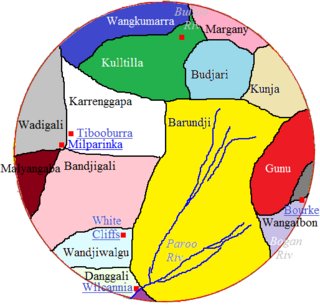This page is based on this
Wikipedia article Text is available under the
CC BY-SA 4.0 license; additional terms may apply.
Images, videos and audio are available under their respective licenses.
The Wandandian were an indigenous Australian people of the South Coast of New South Wales with connections to the Yuin and Tharawal nations.
The Badjiri or Budjari, also written Badyidi, are an Australian Aboriginal people group of Queensland. They are not to be confused with the Pitjara.

The Warkawarka, or as preferred by the community Weki Weki, are an Australian Aboriginal tribe whose traditional lands are located in Victoria, Australia.
The Tulua were an indigenous Australian tribe of Queensland.
The Kuungkari are an indigenous Australian people of Queensland. They are to be distinguished from the Kunggari.
The Kwiambal were an indigenous Australian people of New South Wales.

The Karenggapa are an indigenous people of New South Wales. They might have spoken a dialect of the Yarli language, but there is little data.
The Bitjara or Bithara were an indigenous people of the state of Queensland. They spoke a dialect of the Ngura language. They are not to be confused with the Warrego River Pitjara or the Badjiri of the Paroo River.
The Maranganji were an indigenous Australian people of the state of Queensland.
The Maikulan were an indigenous Australian people of the state of Queensland. They have sometimes been confused with the Maithakari.
The Maikathari (Mayi-Thakurti) were an indigenous Australian people of the state of Queensland.
The Ringaringa (Ringu-Ringu) were an indigenous Australian people of the state of Queensland.
The Yagalingu were an indigenous Australian people of the state of Queensland.
Their language may have been a dialect of Bidjara.
The Yambina were an indigenous Australian people of the state of Queensland.
The Bindal were an indigenous Australian people of the state of Queensland.
The Karingbal (Garaynbal) are an indigenous Australian people of the state of Queensland. They spoke a dialect of Biri.
The Arakwal were an indigenous Australian people of the state of New South Wales.
The Jeithi were an indigenous Australian people of the state of New South Wales.
The Wanjiwalku were an indigenous Australian people of the state of New South Wales.
The Wiyabal were an indigenous Australian people of the state of New South Wales.






